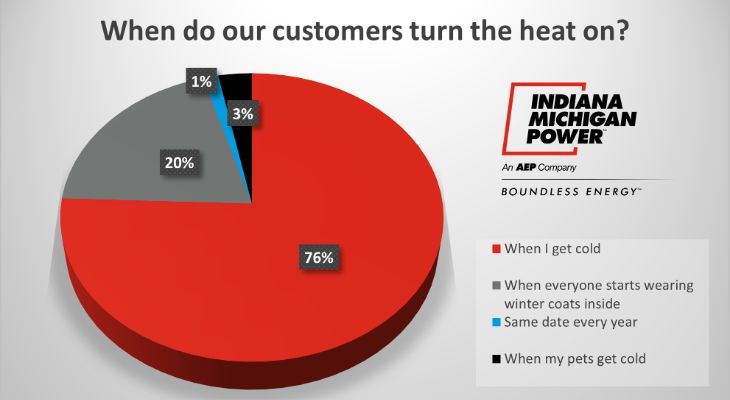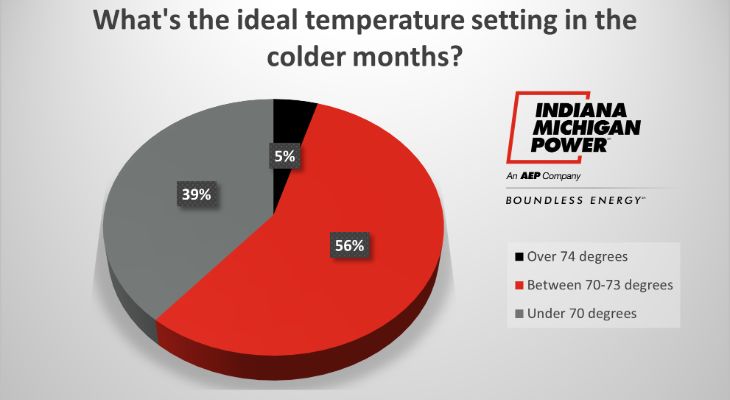
As the temperature gets colder outside, the question of who controls the thermostat in your household can become a heated topic of debate. Who really sets the dial? Is it a roommate or spouse? Are the in-laws or partner changing the setting behind your back? Does the temperature being moved a few degrees up or down cause an all-out rumble?
For the second year running, over 8,000 of Indiana Michigan Power’s (I&M) customers answered these questions in our “Thermostat Rumble” survey.
“Indiana Michigan Power is always looking for fun ways to talk about a household’s most noticeable uses of energy, which is heating and cooling our homes,” said Katie Davis, vice president External Affairs and Customer Experience at I&M. “Our Thermostat Rumble Survey was a unique way for us to celebrate October’s Energy Awareness Month and talk about saving energy.”
A slight majority, around 52%, said that they alone control the thermostat or that they live alone. Around 41% said that it’s a mutual decision with others in the household. Only 7% said that a spouse, partner, or roommate controls the thermostat.

The dilemma of when to turn the heat on in your home can be a big one. A small percentage of our customers turn on the heat at the same time very year, while 76% said that when they get cold is when they turn the heat on. Roughly 20% of respondents said they wait until the last minute, usually when they start seeing everyone donning winter coats inside the house. Sometimes it’s not even the people that decide that, with 3% saying they turn the heat on when their pets get cold.

“I could live in Alaska and my wife would live in Florida. Needless to say, heat is an issue,” said one customer.
We all have different levels of comfort, especially when it comes to the temperature of a home. Around 5% of respondents said that they like to keep it warm, with the thermostat set to above 74 degrees. Over half (56%) keep their homes between 70-73 degrees. The rest (39%) keep it cool, with that thermostat set somewhere under 70 degrees.

For the second year running, customers said the temperature is one of the biggest disagreements among couples, partners, in-laws and roommates. When asked what the biggest disagreements were, they said the temperature was more likely to spark a debate even compared to who’s going to cook dinner or take out the garbage.
“I have become my father when it comes to the temperature of my house and I hate it,” one customer said on the survey.
Who wins those thermostat debates? Nearly 40% said their spouse, partner or roommate wins out on controlling the temperature, while the other 60% said they do.
“Winter is the most fun season to be able to go out and have fun in the snow, but it's also a World War every season between myself, the husband and the kid fighting over what the temperature in the house should be,” responded one of our customers.
Even if you think you won the debate over the thermostat, you may have not won the overall rumble. Sneaking the thermostat setting up or down happens more than you’d think. Around 38% of customers admitted to changing the temp behind a spouse, partner or roommate’s back.
Some of our customers said they had to take drastic measures to keep the thermostat set.
“When my kids were younger and lived at home, I had to keep a lockbox over the thermostat because they would turn it up to 90 degrees,” said another customer.
What else did our survey find?
Nationally, smart thermostat usage is on the rise, but around 83% of customers said that they don’t currently own a Wi-Fi enabled smart thermostat.
We also learned how many of our customers heat their homes:
- 79% use gas heat
- 18% use electric heat
- 3% use other sources for heat including wood, geothermal and more
Save Money on Winter Heating
Being smart about controlling a home’s temperature settings helps save energy, lower energy bills, and stay comfortable. There are hundreds of ways to save energy every day. Check out our collection of energy-saving tips for home and work. For example:
- Set the thermostat a little lower during winter months and it can reduce heating costs about 3% for each degree of adjustment. Changing the temperature from 72 to 68 degrees could lower an energy bill by up to 10%
- Going on vacation? Lower the thermostat to 55 degrees. This will save energy while preventing water pipes from freezing.
- Don’t set the thermostat higher than you want it. It won’t heat the home any faster, and it will keep the furnace running longer than necessary.
For even more tips, visit ElectricIdeas.com to find energy-saving products, rebates and tools to help you save even more at home and at work.